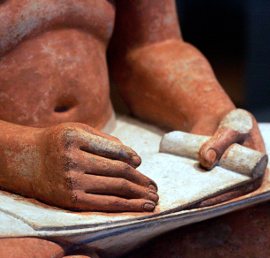Ancient office work hurt
 Ancient Egyptian scribes faced occupational hazards similar to modern office workers, research shows.
Ancient Egyptian scribes faced occupational hazards similar to modern office workers, research shows.
A new study has shed light on the physical toll that the work of ancient Egyptian scribes took on their bodies.
Like modern office workers, these scribes, who were high-status men responsible for administrative tasks and writing, suffered from degenerative skeletal changes due to their repetitive tasks and specific working positions.
Researchers have examined the skeletal remains of 69 adult males from the necropolis at Abusir, Egypt, dating between 2700 and 2180 BCE.
The study, published in Scientific Reports, included 30 scribes and found that they showed more signs of skeletal degeneration compared to men with other occupations.
The analysis identified significant degenerative joint changes among the scribes.
These changes were particularly evident in the joints connecting the lower jaw to the skull, the right collarbone, the top of the right humerus (where it meets the shoulder), the first metacarpal bone in the right thumb, the bottom of the thigh (where it meets the knee), and throughout the spine, particularly at the top.
Additionally, bone changes indicative of physical stress from repeated use were more common in the humerus and left hip bone among the scribes.
The study suggests that these degenerative changes could be linked to the scribes' working positions, as depicted in statues and tomb decorations.
Scribes were often depicted sitting cross-legged with their head bent forward, their spine flexed, and their arms unsupported. Another common position showed them sitting with the left leg in a kneeling or cross-legged position and the right leg bent with the knee pointing upwards.
One intriguing finding relates to the jaw joints, where degeneration was likely due to the scribes chewing the ends of rush stems to form brush-like heads for writing. The repetitive pinching of their pens could also explain degeneration observed in the right thumb.
These findings provide new insights into the daily lives and occupational challenges faced by scribes in ancient Egypt.








 Print
Print